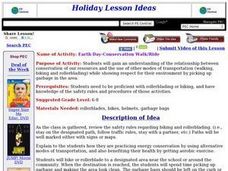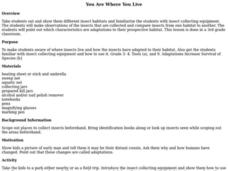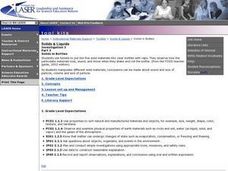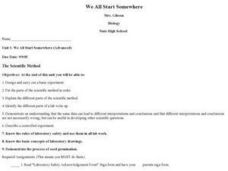Curated OER
Earth Day-Conservation Walk/Ride
Students explore the relationship between conservation of our resources and the use of other modes of transportation (walking, biking and roller blading). They show respect for their environment by picking up garbage in the area. They...
Curated OER
Transmission of Disease
Students provide names of viral diseases that they would possibly like to be infected with today; listing them on the Smart Board. They then come to an agreement about what virus to use and use beakers of fluids to simulate how viruses...
Curated OER
Twisters
Learners differentiate between the terms 'tornado watch' and 'tornado warning' and simulate the conditions that produce tornadoes. They read "Night of the Twisters" by Ivy Ruckman and conduct an experiment using two-liter plastic...
Curated OER
Get Out in the Field
Students visit a shoreline--of an ocean, a lake, a pond, a riverbank, etc., survey it and record what they find there. They map the shoreline and surrounding area and conclude where potential waterfront projects could occur.
Curated OER
Charlotte and Her Relatives Visit the Classroom: Spider Activities, Experiments and Projects
Learners compare and contrast different spider species that they capture and maintain in the classroom for several days. They identify and research the species characteristics and living requirements then conduct an experiment on spider...
Curated OER
What Kind of Insect is That?
Fifth graders characterize insects and classify insects according to the Linnaean system. They use hand lenses or microscopes to examine insect body parts.
Curated OER
Classification
Second graders sort insects into groups by determining similar characteristics. They role play as Entomologists to sort insects.
Curated OER
Insects: Listen and Learn
Fourth graders use their listening skills to make observations of their environment. They study various insects within a natural setting. They, along with their identification of the insect, create a sketch of the insect.
Curated OER
Paper Airplane Scientific Method
Learners explain the steps of the scientific method. In this paper airplane lesson students design and test their own paper airplane.
Curated OER
You Are Where You Live
Students explore where insects live and how they have adapted to their environment.
Curated OER
Physical Difference and Classification
Learners use a microscope and observation skills to compare and contrast several physical properties and develop a classification system.
Curated OER
Twisters
Students build a tornado in a bottle and do various readings to explore tornadoes.
Curated OER
You Are Where You Live
Third graders observe insects in a number of habitats. They recognize which insect characteristics are adaptations to their habitats.
Curated OER
Thunderstorms: A Recipe
Students discover the "recipe" for a thunderstorm. they discuss the "ingrediants" needed to create a thunderstorm and then research a related topic (radar, convection, etc.) and create a webpage about that topic.
Curated OER
Solids in Bottles
Students use funnels to put the five solid materials into clear bottles with caps. They observe how the particulate materials look, sound, and move when they shake and roll the bottle. Finally, students write "sound and touch" poetry.
Curated OER
4-H Horse Activity Page
In this animal science worksheet, learners read information about the care of horses and tack, check off activities which they can do to learn about horses and think about the attributes of different horse breeds. Students also label a...
Curated OER
Types of Reactions
In this reactions worksheet, students describe combustion as either exothermal or endothermal. Students balance reactions and label the types of reactions. This worksheet has 1 multiple choice, 2 short answer, and 10 problem solving...
Curated OER
Seltzer Breath
High schoolers investigate "indicator" (Bromothymol Blue or BTB) to test for the presence of certain chemicals in liquids and gases. They compare distilled water and seltzer water for presence of carbon dioxide.
Curated OER
We All Start Somewhere
Students demonstrate an understanding that the same data can lead to different interpretations and conclusions and that different interpretations and conclusions are not necessarily wrong, but can be useful in developing other scientific...
Curated OER
Galloping Who?
Third graders do an Internet search to find out about Galloping Gertie and what caused the bridge to fail.
Curated OER
Bleach Chemical Reactions
Students learn what happens when bleach comes in contact with various cloth fibers, chemical colors, nature and synthetics.
Curated OER
Make It All Better!
Students design an innovation that could help their community. In this technology instructional activity, students identify problems that could be solved by innovation. They present their ideas in class.
Curated OER
My Feelings
First graders examine and discuss different emotions and feelings, and how people can react when they are in an unsafe situation. They discuss a feelings thermometer, and complete a worksheet involving identifying how they feel in...
Curated OER
Frog Dissection Lesson Plans
Check out these lesson plans for both actual and virtual frog dissections.

























